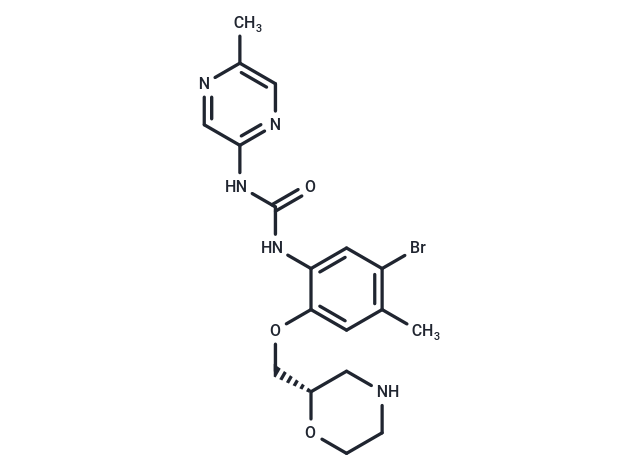Shopping Cart
- Remove All
 Your shopping cart is currently empty
Your shopping cart is currently empty

Rabusertib (IC-83) is an inhibitor of the cell cycle checkpoint kinase 1 (chk1) with potential chemopotentiating activity. Rabusertib has been used in trials studying the treatment of Cancer, Solid Tumors, Advanced Cancer, Pancreatic Neoplasms, and Non-Small Cell Lung Cancer.

| Pack Size | Price | Availability | Quantity |
|---|---|---|---|
| 5 mg | $38 | In Stock | |
| 10 mg | $59 | In Stock | |
| 25 mg | $119 | In Stock | |
| 50 mg | $179 | In Stock | |
| 100 mg | $272 | In Stock | |
| 200 mg | $396 | In Stock |
| Description | Rabusertib (IC-83) is an inhibitor of the cell cycle checkpoint kinase 1 (chk1) with potential chemopotentiating activity. Rabusertib has been used in trials studying the treatment of Cancer, Solid Tumors, Advanced Cancer, Pancreatic Neoplasms, and Non-Small Cell Lung Cancer. |
| Targets&IC50 | Chk1:7 nM |
| In vitro | Chk1 is an ATP-dependent serine-threonine kinase and a key component in the DNA replication-monitoring checkpoint system activated by double-stranded breaks (DSBs). Chk1 contributes to all currently defined cell cycle checkpoints, including G1/S, intra-S-phase, G2/M, and the mitotic spindle checkpoint. By inhibiting the activity of chk1, Rabusertib prevents the repair of DNA caused by DNA-damaging agents, thus potentiating the antitumor efficacies of various chemotherapeutic agents. However, preClinicalal data involving Rabusertib has not been published until now. [1] Inhibition of Chk1 is predicted to enhance the effects of antimetabolites, such as gemcitabine. [2] Rabusertib treatment impairs DNA synthesis, increases DNA damage (via mitotic defects), induces apoptosis, and has synergistic activity with pemetrexed, especially in p53 mutant tumor cells. [3] |
| In vivo | In xenograft models, LY2603618 delays tumor growth when given in combination with pemetrexed. [3] |
| Kinase Assay | Protein kinase assays are performed variously. Assays are performed on the following protein kinases: ABL, AKT1, ARG, CAMK2, CDK1, CDK2, CHK1, CHK2, DAPK1, EGFR, EPHA1, EPHB2, EPHB3, EPHB4, ERK1, ERK2, FES, FGFR1, FGFR3, FGFR4, FGR, HCK, HER2, INSR, JNK1, JNK2, LCK, MET, NTRK1, NTRK2, p38α, p38β, p38δ, p38γ, p70S6K, PDGFRα, PDGFRβ, PDK1, PKCα, ROCK2, ROS, RSK2, SGK1, SRC, SYK, TAK1, TYRO3, VEGFR2, VEGFR3, YES, ZAP70[1]. |
| Cell Research | LY2603618 is prepared in DMSO (10 mM) and stock, and then diluted 1000-fold into medium[1]. Cells are plated at 2.5×103 per well, on 96-well tissue culture plates and incubated for one cell doubling (18-24 h). Gemcitabine dilutions are set up by half-log steps across a final concentration range of 1-1000 nM. LY2603618 is prepared by dilutions in DMSO to 5000× final concentration, and then diluted 1000-fold into medium to generate 5× stocks for addition to wells. Approximately 24 h after Gemcitabine addition, LY2603618 is added. Each combination is done in triplicate. After a period of two cell doublings following LY2603618 addition, MTS/PMS reagent is added to each well according to the manufacturer's instructions. Absorbance is read on a Spectra Max 250 spectrophotometer at 490 nm and the data analyzed with GraphPad Prism 4.0. Dose-response curves are fit by non-linear regression, with bottom fits constrained to 0 % inhibition[1]. |
| Alias | LY2603618, IC-83 |
| Molecular Weight | 436.3 |
| Formula | C18H22BrN5O3 |
| Cas No. | 911222-45-2 |
| Smiles | Cc1cnc(NC(=O)Nc2cc(Br)c(C)cc2OC[C@@H]2CNCCO2)cn1 |
| Relative Density. | 1.461 g/cm3 |
| Storage | Powder: -20°C for 3 years | In solvent: -80°C for 1 year | Shipping with blue ice. | ||||||||||||||||||||
| Solubility Information | DMSO: 4.36 mg/mL (10 mM), Sonication is recommended. H2O: < 1 mg/mL (insoluble or slightly soluble) Ethanol: < 1 mg/mL (insoluble or slightly soluble) | ||||||||||||||||||||
Solution Preparation Table | |||||||||||||||||||||
DMSO
| |||||||||||||||||||||

Copyright © 2015-2024 TargetMol Chemicals Inc. All Rights Reserved.